1997 BUICK REGAL sensor
[x] Cancel search: sensorPage 38 of 422
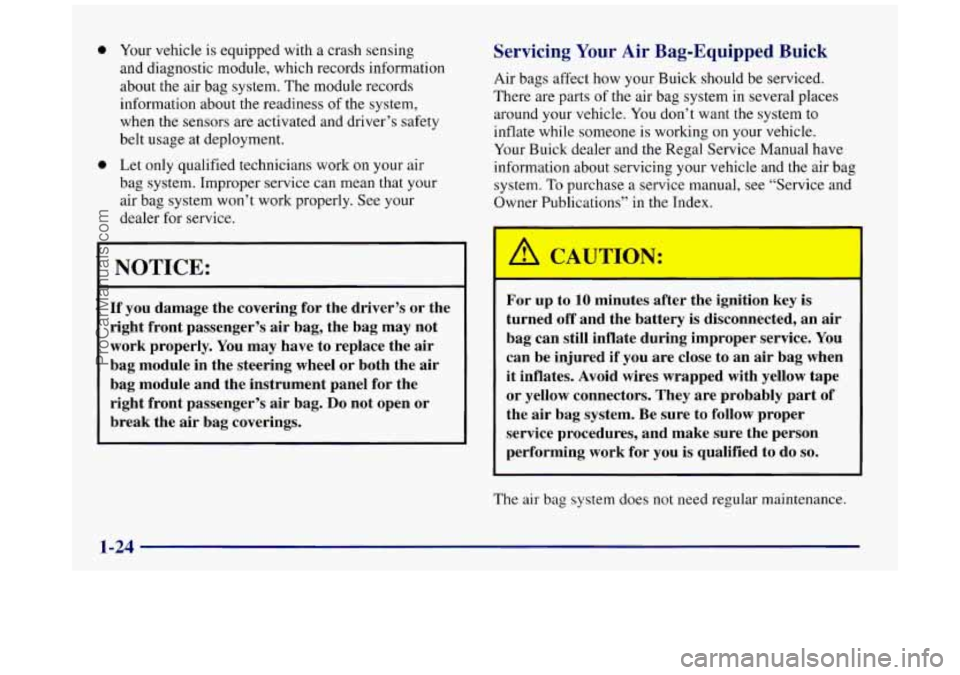
0
0
Your vehicle is equipped with a crash sensing
and diagnostic module, which records information
about the air bag system. The module records
information about the readiness
of the system,
when the sensors are activated and driver’s safety
belt usage at deployment.
Let only qualified technicians work on your air
bag system. Improper service can mean that your
air bag system won’t work properly. See your
dealer for service.
NOTICE:
If you damage the covering for the driver’s or the
right front passenger’s air bag, the bag may not
work properly. You may have to replace the air
bag module in the steering wheel or both the air
bag module and the instrument panel for the
right front passenger’s air bag.
Do not open or
break the air bag coverings.
Servicing Your Air Bag-Equipped Buick
Air bags affect how your Buick should be serviced.
There are parts of the air bag system in several places
around your vehicle. You don’t want the system to
inflate while someone is working on your vehicle.
Your Buick dealer and the Regal Service Manual have
information about servicing your vehicle and the air bag
system.
To purchase a service manual, see “Service and
Owner Publications” in the Index.
I
UTION:
I
For up to 10 minutes after the ignition key is
turned off and the battery is disconnected, an air
bag can still inflate during improper service. You
can be injured if you are close to an air bag when
it inflates. Avoid wires wrapped with yellow tape
or yellow connectors. They
are probably part of
the air bag system. Be sure to follow proper
service procedures, and make sure the person
performing work for you is qualified to do
so.
The air bag system does not need regular maintenance.
I
ProCarManuals.com
Page 101 of 422
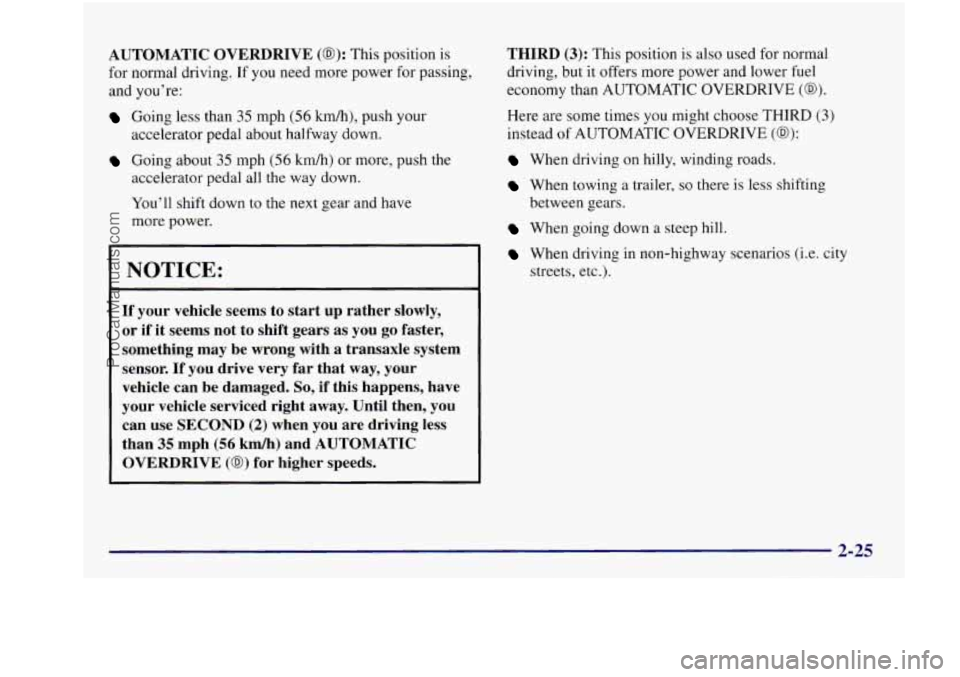
AUTOMATIC OVERDRIVE (0): This position is
for normal driving. If you need more power for passing,
and you’re:
Going less than 35 mph (56 kmh), push your
Going about 35 mph (56 kmk) or more, push the
accelerator pedal about
halfway down.
accelerator pedal all the way down.
You’ll shift down to the
next gear and have
more power.
NOTICE:
I If your vehicle seems to start up rather slowly,
or
if it seems not to shift gears as you go faster,
something may be wrong with a transaxle system
sensor.
If you drive very far that way, your
vehicle can be damaged.
So, if this happens, have
your vehicle serviced right away. Until then, you
can use SECOND
(2) when you are driving less
than
35 mph (56 km/h) and AUTOMATIC
OVERDRIVE (0) for higher speeds.
THIRD (3): This position is also used for normal
driving, but it offers more power and lower fuel
economy than AUTOMATIC OVERDRIVE
(@).
Here are some times you might choose THIRD (3)
instead of AUTOMATIC OVERDRIVE (0):
When driving on hilly, winding roads.
When towing a trailer, so there is less shifting
When going down a steep hill.
When driving in non-highway scenarios (i.e. city
between
gears.
streets, etc.).
2-25
~
ProCarManuals.com
Page 118 of 422
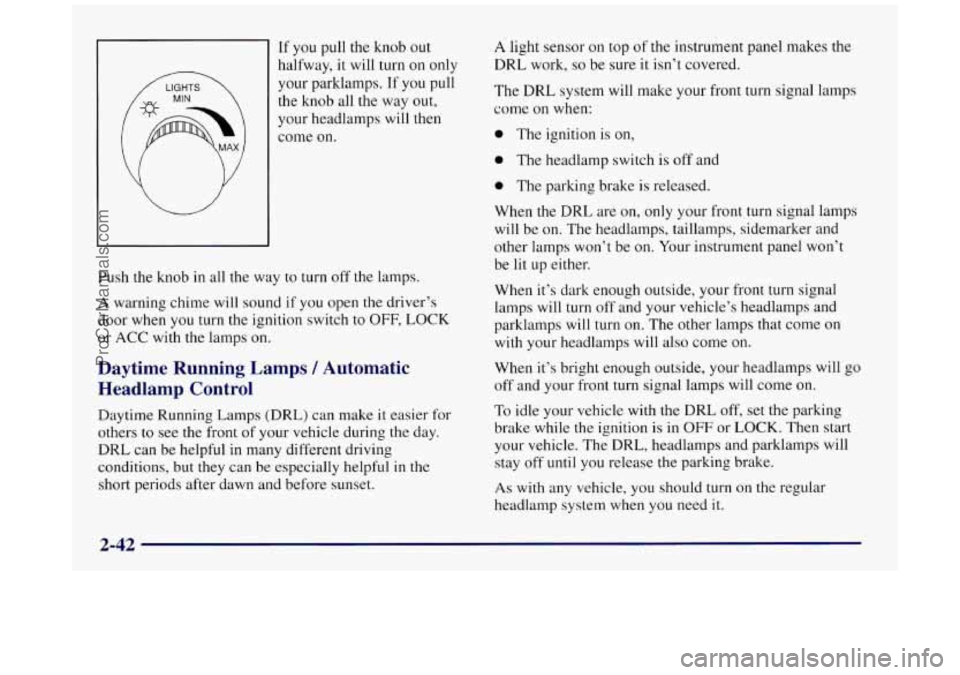
If you pull the knob out
halfway,
it will turn on only
your parklamps. If you pull
the knob all the way out,
your headlamps
will then
come on.
Push the knob
in all the way to turn off the lamps.
A warning chime will sound if you open the driver’s
door when you turn the ignition switch to
OFF, LOCK
or
ACC with the lamps on.
Daytime Running Lamps / Automatic
Headlamp Control
Daytime Running Lamps (DRL) can make it easier for
others to see the front
of your vehicle during the day.
DRL can be helpful in many different driving
conditions, but they can be especially helpful
in the
short periods after dawn and before sunset.
A light sensor on top of the instrument panel makes the
DRL work,
so be sure it isn’t covered.
The DRL system will make your front turn signal lamps
come on when:
0 The ignition is on,
0 The headlamp switch is off and
0 The parking brake is released.
When the DRL are on, only your front turn signal lamps
will be on. The headlamps, taillamps, sidemarker and
other lamps won’t be on. Your instrument panel won’t
be lit up either.
When it’s dark enough outside, your front turn signal
lamps will turn off and your vehicle’s headlamps and
parklamps will turn
on. The other lamps that come on
with your headlamps will also come on.
When it’s bright enough outside, your headlamps will
go
off and your front turn signal lamps will come on.
To idle your vehicle with the DRL off, set the parking
brake while
the ignition is in OFF or LOCK. Then start
your vehicle. The DRL, headlamps and parklamps will
stay off until you release the parking brake.
As with any vehicle, you should turn on the regular
headlamp system when you need
it.
2-42
ProCarManuals.com
Page 148 of 422
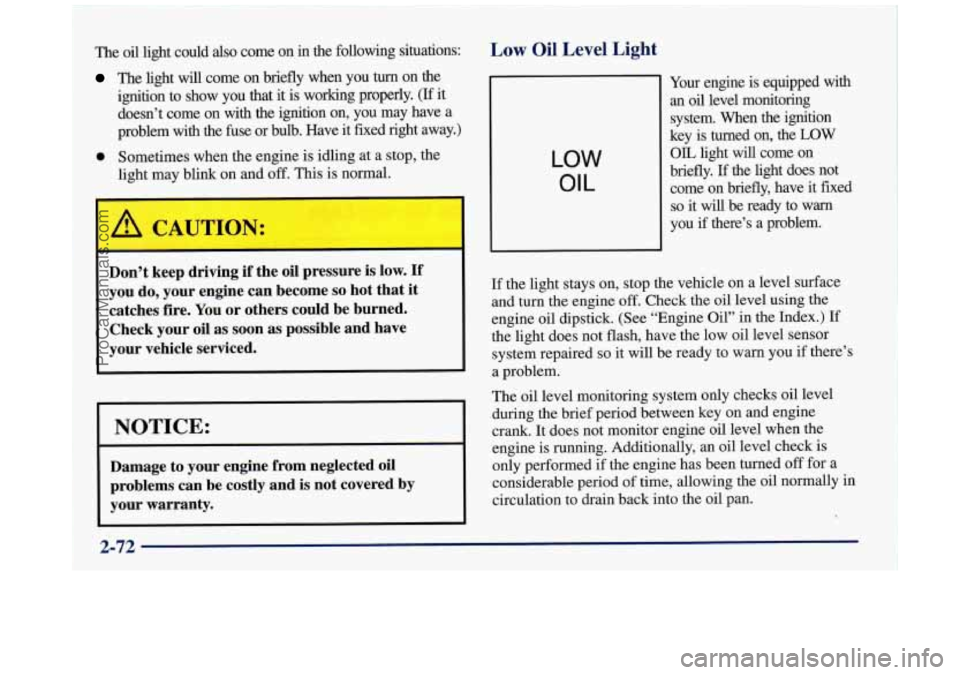
The oil light could also come on in the following situations:
The light will come on briefly when you turn on the
ignition to show you that it is working properly.
(If it
doesn’t come on with the ignition on, you may have
a
problem with the fuse or bulb. Have it fixed right away.)
0 Sometimes when the engine is idling at a stop, the
light may blink on and
off. This is normal.
Don’t keep driving if the oil pressure is low. If
you do, your engine can become so hot that it
catches fire. You
or others could be burned.
Check your oil as soon as possible and have
your vehicle serviced.
NOTICE:
Damage to your engine from neglected oil problems can be costly and is not covered by
your warranty.
Low Oil Level Light
LOW
OIL
Your engine is equipped with
an oil level monitoring
system. When
the ignition
key is turned on, the
LOW
OIL light will come on
briefly.
If the light does not
come on briefly, have it fixed
so it will be ready to warn
you if there’s a problem.
If the light stays on, stop the vehicle on a level surface
and turn the engine
off. Check the oil level using the
engine oil dipstick. (See “Engine Oil” in the Index.)
If
the light does not flash, have the low oil level sensor
system repaired
so it will be ready to warn you if there’s
a problem.
The oil level monitoring system only checks oil level
during the brief period between key
on and engine
crank. It does not monitor engine oil level when the
engine is running. Additionally, an oil level check is
only performed if
the engine has been turned off for a
considerable period of time, allowing the oil normally in
circulation to drain back into the oil pan.
2-72
ProCarManuals.com
Page 248 of 422
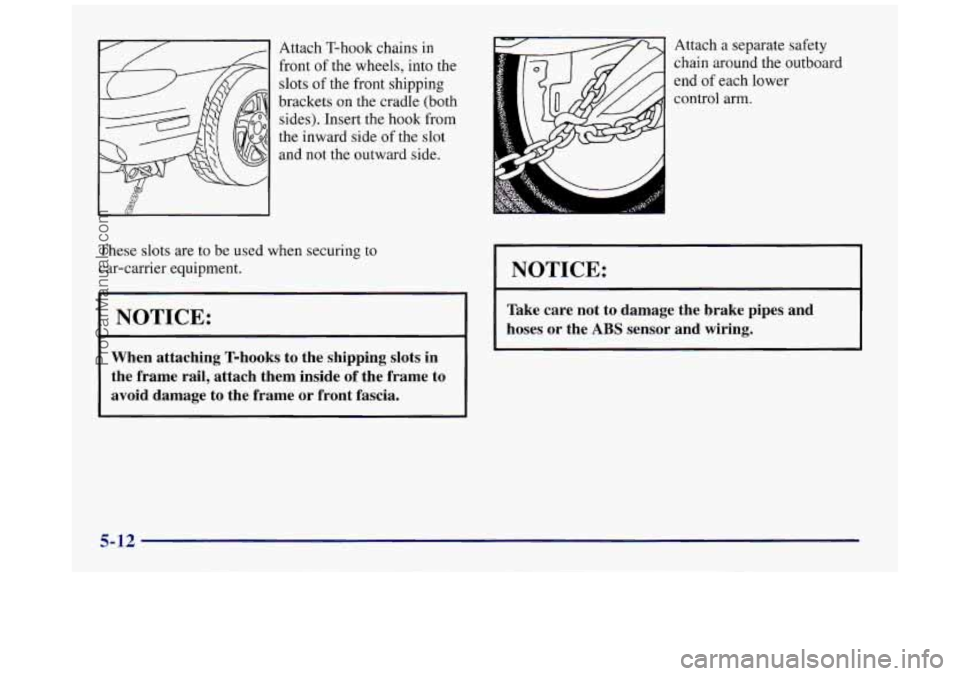
Attach T-hook chains in
front of the wheels, into the
slots of the front shipping
brackets on the cradle (both
sides). Insert the hook from
the inward side
of the slot
and not the outward side.
I
These slots are to be used when securing to
car-carrier equipment.
NOTICE:
When attaching T-hooks to the shipping slots in
the frame rail, attach them inside
of the frame to
avoid damage to the frame or front fascia.
Attach a separate safety
chain around the outboard
end of each lower
control arm.
/A
NOTICE:
Take care not to damage the brake pipes and
hoses or the
ABS sensor and wiring.
5-12
ProCarManuals.com
Page 338 of 422
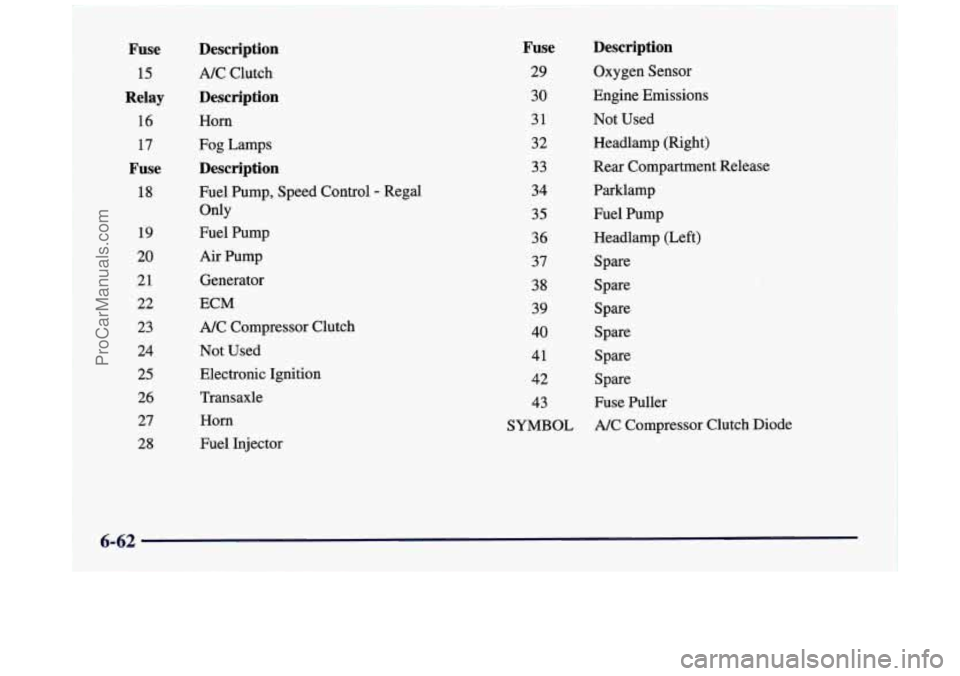
Fuse
15
Relay
16 17
Fuse
18
19
20
21
22 23
24
25
26
27
28
Description
A/C Clutch
Description
Horn
Fog Lamps
Description
Fuel Pump, Speed Control - Regal
Only
Fuel Pump
Air Pump
Generator
ECM
A/C Compressor Clutch
Not Used
Electronic Ignition
Transaxle
Horn
Fuel Injector
Fuse
29
30
31
32 33
34
35
36
37
38
39
40 41
42
43
SYMBOL
Description
Oxygen Sensor
Engine Emissions
Not Used
Headlamp (Right)
Rear Compartment Release
Parklamp
Fuel Pump
Headlamp (Left)
Spare
Spare Spare
Spare
Spare
Spare
Fuse Puller
A/C Compressor Clutch Diode
ProCarManuals.com